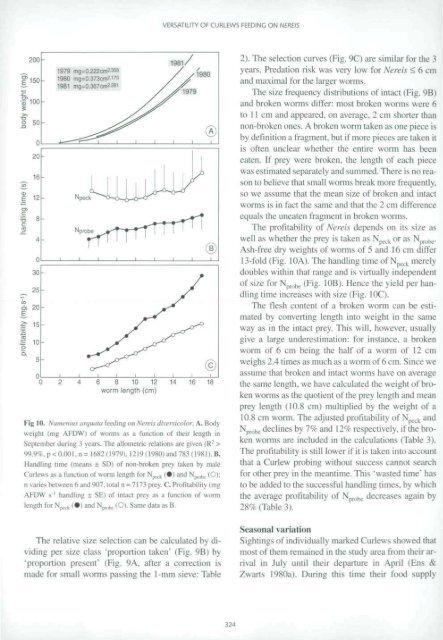waders and their estuarine food supplies - Vlaams Instituut voor de ...
waders and their estuarine food supplies - Vlaams Instituut voor de ...
waders and their estuarine food supplies - Vlaams Instituut voor de ...
You also want an ePaper? Increase the reach of your titles
YUMPU automatically turns print PDFs into web optimized ePapers that Google loves.
6 8 10 12 14 16 18<br />
worm length (cm)<br />
Fig IO. Numenius arquata feeding on Nereis diversicolor. A. Body<br />
weighl (mg AFDW) of worms as a function of <strong>their</strong> length in<br />
September dunne 3 years. Hie allometik relations ate given (R-' ><br />
99.9*5!-. p < 0.001. n = 1682 (1979). 1219 (19X0) <strong>and</strong> 7X3 (19X1). B.<br />
H<strong>and</strong>ling time (means ± SD) of non-broken prey taken by male<br />
Curlew s as a function of worm length for N^ (•) <strong>and</strong> N^,,,. (O);<br />
n varies between 6 <strong>and</strong> 907; total n = 7171 prey. C. Profitability<br />
AFDW s ' h<strong>and</strong>ling ± SI-.i of inlact prey .is a function ol worm<br />
length lor N—j (•) <strong>and</strong> N ^ (O). Same data as IJ.<br />
The relative size selection can be calculated by dividing<br />
per size class 'proportion taken' (Fig. 9B) by<br />
proportion present' (Fig. 9A. after a correction is<br />
ma<strong>de</strong> for small worms passing the 1-mm sieve: Table<br />
VERSATILITY OF CURLEWS FEEDING ON NEREIS<br />
324<br />
2). The seleciion curves (Fig. 9C) are similar for the 3<br />
years. Predation risk was very low for Nereis < 6 cm<br />
<strong>and</strong> maximal for the larger worms.<br />
The si/.e frequency distributions of intact (Fig. 9B)<br />
<strong>and</strong> broken worms differ: most broken worms were 6<br />
to 11 cm <strong>and</strong> appeared, on average. 2 cm shorter than<br />
non-broken ones. A broken worm taken as one piece is<br />
by <strong>de</strong>finition a fragment, but if more pieces are laken u<br />
is often unclear whether ihe entire worm has been<br />
eaten. If prey were broken, die lengih of each piece<br />
was estimated separately <strong>and</strong> summed. There is no reason<br />
to believe thai small worms break more frequently,<br />
so we assume that the mean size of broken <strong>and</strong> intact<br />
worms is in fact the same <strong>and</strong> that the 2 cm difference<br />
equals the uneaten fragment in broken worms.<br />
The profitability of Nereis <strong>de</strong>pends on its si/c as<br />
well as whether the prey is taken as N|lciA or as N olK.<br />
Ash-free dry weights of worms of 5 <strong>and</strong> 16 cm differ<br />
13-fold (Fig. 10A). The h<strong>and</strong>ling time of N k merely<br />
doubles within that range <strong>and</strong> is virtually in<strong>de</strong>pen<strong>de</strong>nt<br />
of size for Npri)hc (Fig. 10B). Hence the yield per h<strong>and</strong>ling<br />
lime increases \\ ith si/.e (Fig. IOC).<br />
The llesh contenl of a broken worm can be estimated<br />
by converting length into weight in the same<br />
way as in the intact prey. This will, however, usuallv<br />
give a large un<strong>de</strong>restimation: for instance, a broken<br />
worm of 6 cm being the half of a worm of 12 cm<br />
weighs 2.4 times as much as a worm of 6 cm. Since we<br />
assume lhat broken <strong>and</strong> intact worms have on average<br />
ihe same length, we have calculated the weight of broken<br />
worms as the quotient of the prey length <strong>and</strong> mean<br />
prev length (10.8 cm) multiplied by the weight of a<br />
10.8 cm worm. The adjusted profitability of Np,,c.k <strong>and</strong><br />
Nprotx <strong>de</strong>clines by 1% <strong>and</strong> 129; respectively, if ihe broken<br />
worms are inclu<strong>de</strong>d in the calculations (Table 3).<br />
The profitability is still lower if il is taken into account<br />
that a Curlew probing without success cannot search<br />
for other prey in the meantime. This 'wasted time* has<br />
to be ad<strong>de</strong>d to the successful h<strong>and</strong>ling times, by which<br />
the average profitability of Nprohc <strong>de</strong>creases again by<br />
:s". (Table3).<br />
Seasonal variation<br />
Sightings of individually marked Curlews showed thai<br />
most of them remained in the study area In un <strong>their</strong> arrival<br />
in July until <strong>their</strong> <strong>de</strong>parture in April (Ens &<br />
Zwarts 1980a). During this time <strong>their</strong> <strong>food</strong> supply

















